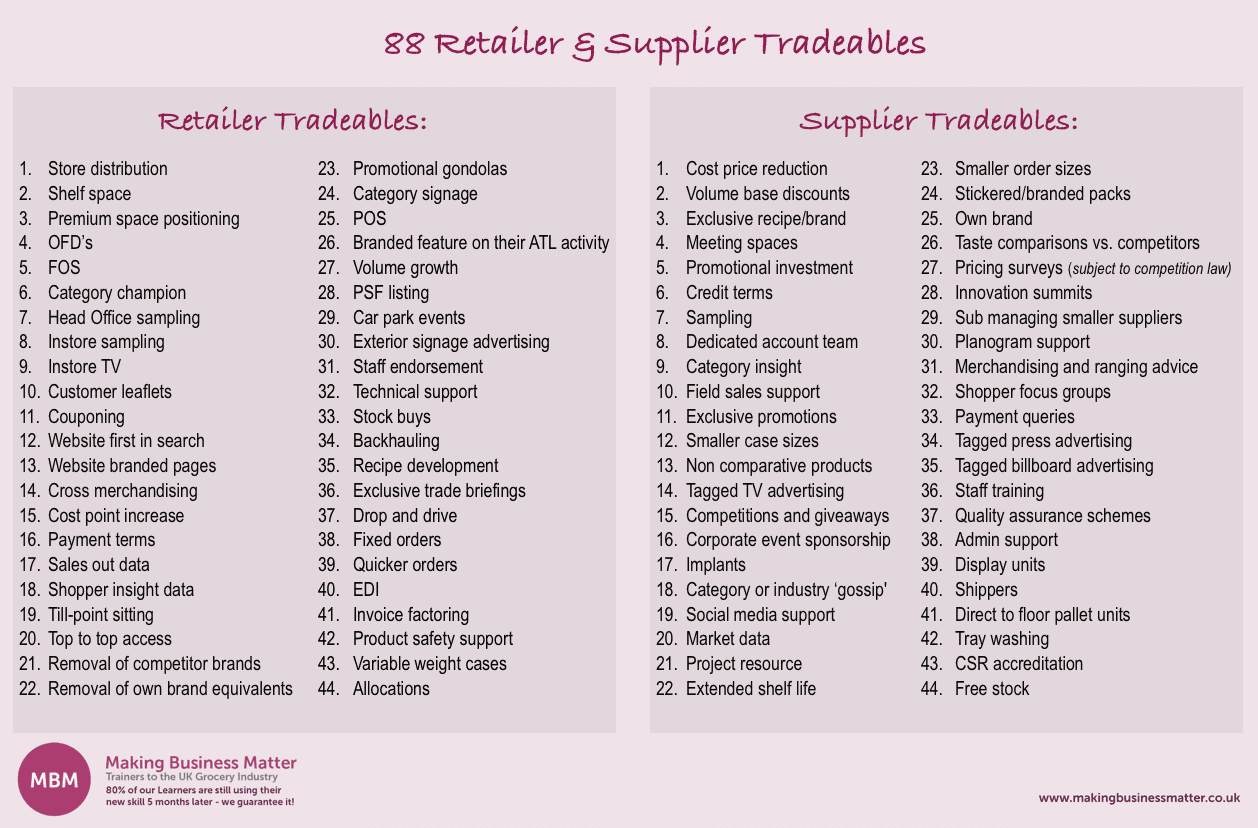Top 50 Negotiation Techniques
The following is a list of 50 useful negotiation techniques, tools and strategies for account managers to adopt when negotiating terms with a supermarket buyer. For even more helpful negotiation tips and advice, check out our Ultimate Guide to Negotiation Skills.
1. Either / Or
Use when reluctant to make a proposal or are afraid the proposal will be rejected out-of-hand.
Even if the other party doesn’t like either option, you can ask which of the two they prefer and so open a dialogue.
2. Russian Front
Similar to an Either / Or proposal. In this case, one of the options is deliberately designed to be unattractive in order to force the other party to choose the option you favour.
3. Open Door…
A negotiation technique to use when faced with a surprise demand or proposal. If you say ‘yes’, you risk an unconditional concession. If you say ‘no’, you risk deadlock. Instead, use one of the terms ‘just suppose…’, ‘what if…’ By using any of these, it keeps your response conditional and without commitment.
Sticky Learning ® is 7 times more effective than 1-day training courses. Plus, you will get a Chain of Evidence proving your Return on Investment. Discover soft skills training that changes behaviours long term.

4. Argument Dilution – An Effective Negotiation Technique
Don’t be tempted to provide too many reasons to support your proposal. Often each reason will be weaker than the previous one, steadily diluting your first and perhaps second strong ones. If you have a good reason for doing something, give it and shut up!
When receiving reasons, receive them in silence and wait for the other party to dilute it until you can pick it off easily!
5. Out of Bounds
If there is an element or point over which you are not prepared to negotiate, your apparent inflexibility may annoy the other party. Try signalling that whilst this particular point is non-negotiable, you can be flexible with the various other points being negotiated.
6. Up and Over Negotiation Method
When you are faced with an unreasonable demand, there is a temptation to argue against it. This can leave the person making the demand with the upper hand; a proposal beats an argument. The best response is to put an equal price on the demand; the bigger the demand, the bigger the price. This helps the other party to understand the implications of their demand on the outcome of the deal. This is usually used as a blocking tactic and is not meant to be accepted. Having blocked their demand, you have the opportunity to take the initiative and make a realistic proposal of your own.
7. Deadlock
Don’t be afraid of using deadlock, it can be a useful negotiation technique in the right circumstances. For example, it puts pressure on the other party when they have a deadline to meet. But… it is only a temporary tactic and brings with it inherent risks. For instance, escalation of the conflict, withdrawal of earlier concessions and increased sanction behaviour. If the other party uses deadlock, try to understand whether they are genuine or just bluffing.
To break the deadlock: give the other party the opportunity to save face, repackage your demands to take into account their inhibitions, introduce new variables or substitute or compensate for the deadlocked issue, adjourn or use the passing of time to defer the issue and take the emotion out of the conflict.

8. Deal Creep Negotiation Technique
Don’t take advantage of ambiguities in the supposed agreed deal. The temptation may be to re-interpret the agreement in your favour…don’t! Contact them and summarise your interpretation to them. You have the initiative and there’s a good chance they may agree with your version. If not, you have kept credibility by raising it as a query.
9. Add-On / Take Away
The main part of your negotiation has been agreed too low. Add items from your wish list before agreeing to the whole deal. Think Porsche: only £25,000…plus £3,000 for the alloy wheels, £2,500 for air conditioning etc. Your opening position is too high? Don’t reduce the price, but throw in a few concessions to make the deal more acceptable: price includes VAT; order now and get 5% discount etc.
10. Salami
Don’t trade concessions in large lumps. Try to slice them into smaller concessions as it gives greater flexibility when bargaining.
11. Irritant Factor
Introduce something that is unimportant to you, but causes great inconvenience for the other party. The price to drop the irritant factor is another concession from the other party. However, if it is perceived as a completely new and unrelated issue (therefore just a ploy), it may provoke a competitive reaction. If it is something related to the deal and you are perfectly justified, you should be OK.
12. The Shopping List Negotiation Technique
If your proposal contains several aspects or several different items (the shopping list), you should aim to negotiate and agree on each aspect or item separately. This way you are likely to maximise your side of the deal. However, be careful not to ask for too much when using this negotiation technique; that last small item might be the ‘straw that breaks the camel’s back’ and then you are back to square one!
When you find yourself on the receiving end of a shopping list, you need to flush out all the aspects or items. You can do this by a trial close. Once you are happy you have everything on the table, try to get the other party to prioritise their list. You can then trade items further down their list with the more important items at the top, thereby reducing the overall value of their demands.
13. Big Outrageous Ask
Sometimes you may be surprised at what you can get if you only just ask! Especially useful and effective if you have limited or no knowledge of the other party’s position of power and strength and/or if you perceive yourself to be in a strong negotiating position. You can always rail back from it if needed.
14. Bleed Your Trades
When moving positions in any negotiation, always move in small increments and make each one look as if it is positively painful for you. Large moves especially in the early stages of a negotiation show you have lots of room for manoeuvre. This could antagonise the other party who will perceive you are playing negotiation ‘games’. Always move to smaller and smaller increments as the negotiation progresses to its conclusion – this shows the other party you have very little left to give and signals they need to close and agree.
15. Low Cost, High-Value Tradeables
Tradeables are the ‘oil’ of successful negotiations. Always trade things that are low cost for you to give but are or are perceived to be of higher value to the other side. Conversely, always look for tradeables from the other party that are low cost for them to give but you put a high value on. Tradeables generation is one of the fundamental negotiation planning tools – the more tradeables you have the more likely you are to reach an agreement. If all you trade is money then you will reach a deadlock, as effectively one side is looking to buy a £20 note for £10, whilst the other wants £30 for it! The following is a list of tradeables that can be used to aid negotiation in the UK Grocery Industry:

16. Ambition Negotiation Technique
One of the fundamentals of successful negotiation. Being ambitious at all stages of the negotiation – preparation, start, middle and at the end will drive bigger, better deals for you – remember to always ask for more than you need in every aspect of the negotiation and bleed your trades (see above).
17. False Walkaway
A potentially high-risk negotiation technique, but one you should be aware of and deploy only after careful, balanced consideration. A false walk away, if done with confidence and poise, can ‘spook’ the other side into thinking the negotiation is over and they will lose out thereby forcing a sudden series of concessions to rescue the deal. However, beware of having your false walkaway accepted and losing the deal yourself, or of getting a reputation for ‘crying wolf’ and constantly deploying a false walkaway position.
18. Spiders Web
This negotiation technique draws the other side into a web of numbers, acronyms and data that bolsters your argument and position and weakens theirs. It traps them in a ‘spiders web’ of technical or financial data that they struggle to process at the same speed as you. For example, ‘If we take your proposed price and offset it on a straight line cumulative basis based on yesterday’s 3-month future spot rate on the Hang Seng Index then you need to apply a linearly based discount of 6.23%’.
19. Soft Language
Soft language or weak language either adds confusion to the negotiation, with the other side unsure of exactly what you mean or worse still signals your adopted position is not firm. Cut any soft language from your negotiations – you will come across as more confident, firmer and above all clear. Examples of soft language are: ‘my opening proposal is as follows’, ‘the price is between £30 and £50’, ‘we could offer say around about a 5% ish discount’ and ‘I’d be happy to accept that offer’.
20. Brinkmanship Negotiation Technique
A more extreme version of deadlock – also known as ‘cutting off your nose to spite your face’. Here, as well as putting the other side into Deadlock (see above), you accompany it with a huge, unpleasant threat. This will not only hurt them but will potentially also damage you too. The hope is that the other side ‘blinks first’ and does not call your bluff. The key question to ask yourself before deciding whether to use this tool is: are you willing to go through with the threat and can you live with the consequences? If the answer is ‘no’ then don’t use Brinkmanship!
21. Super Size Me
A great negotiation technique for senior negotiators to deploy without undermining their lead negotiator. Greater seniority usually means a more strategic, longer-term viewpoint and greater budgetary sign-off and responsibility. These can be used to introduce a ‘Super Size Me’ option in a negotiation to bring the deal up from small scale ‘nitty gritty’ detail to the big picture, blue sky opportunities that explode out the potential size of the deal for both sides.

22. Roadblock
Similar to ‘Out Of Bounds’ (see above), you introduce a legislative or procedural ‘Roadblock’ into the negotiation to prevent you having to cede ground in a particular area. Because of its legal or procedural nature, it makes it hard for the other side to circumvent, thereby protecting your position behind the roadblock.
23. Steeplechase
Making the other side jump over numerous hurdles which saps their energy, consumes their time and resources and forces them to give up value. A negotiation technique often deployed in contract tenders to whittle down a potential field of bidders whilst extracting value from them at each ‘hurdle’.
24. Future Promise Negotiation Technique
Trading something that may or may not happen in the future for the other party for something of immediate value to you. The more attractive and enticing the Future Promise, the more likely the other side is to trade something of immediate high value to you.
25. Dutch Auction
Two negotiating parties are set to bid and compete against each other. As the bids go up and winning becomes more a priority than rational judgement, the receiving negotiator can get more concessions than they would have without competition.
26. If You Then I…
Probably the most famous of all the negotiation techniques. It is simple, yet effective as it helps us to construct a proposal effectively. For example, when you want to propose, you would say, ‘If you can give me £5 per case, then I will give you some free stock’. The advantage of constructing the sentence this way is that the other is more likely to listen because the bit that they want is second. If you were to say, ‘If I give you free stock, you then give me £5 per case’, they may cut you off mid-sentence, offer their hand, only having heard what they can get.
27. Silence or Active Listening
Many amateur negotiators seem to believe that negotiating is all about talking fast and being mean. It isn’t. However, all to often it can be. I have found that the most effective negotiators are those that ask good questions and listen. They listen for what is really being said. This, of course, means listening for what is not being said and looking for the small words that give it away. For example, ‘I’ll take around £4.25 per case’. The giveaway, or tell, was ‘around’.
28. Adjourn Negotiation Technique
Very few people seem to use adjourn, yet it is very powerful negotiation technique. Simply put, it is taking a break in a negotiation to re-group. The challenge when you do agree to adjourn is to ensure you re-group more effectively than the other party. The purpose of adjourning is normally because the negotiation is not achieving what you need. Taking a break will help you refocus and look at the negotiation another way. It can be a few minutes or sometimes longer. To adjourn, you might say, ‘We don’t seem to be making progress. I suggest a short break. Would that be ok?’

29. Mock Shock
This involves suggesting that the other party’s inability to make decisions or commit to the deal will result in grave consequences or loss of profit for them. This can be used for smaller tasks or deliverables, implying that their failure with that small project can heavily affect all other businesses with your team or a larger group.
30. Broken Record
Persistence is key to this technique. Like a broken record, keep repeating the offer or demand until its importance is established.
31. Trojan Horse
As the famous Greek proverb warns, ‘beware of Greeks bearing gifts.’ Deals that seem too good to be true or too good to pass may have underlying or hidden problems. Often, these problems will only be fully revealed once you’ve entered into a contract. When a buyer/seller immediately accepts fixed prices (or your initial offer) without even negotiating, a little research on the project wouldn’t hurt.
32. The Professional Flinch Negotiation Technique
This negotiation technique requires a little amateur dramatics. It involves implying that an offer’s terms are too ridiculous compared to the standard norms. A flinch line would say ‘this can’t be serious’ or ‘give me the other offer’. This suggests that if the negotiators are serious, then the deal will not materialise.
33. Linking the Issues
Encouraging movement in the negotiation by establishing a connection between issues that have been previously thought as separate items with the use of an issue map. This creates a contingent relationship between the now related issues that can now be traded.
34. Pre-emptive Strike
Offering a solid deal that forestalls any chance of negotiation. Surprise deals such as ‘I have a requirement for 100 orders of X item. Give it to me at X price and the deal is yours.’ This can induce panic, leading the other party to agree.
35. Higher Authority
Showing that you have limits in your approval power and saying if they can agree to a certain price, you can get your boss/someone of higher position than you to agree to a deal. This gives the perception that you want to help the other side as well while working within your limits.
36. ‘Why?’ Negotiation Technique
Do not be afraid to challenge aspects of a proposal. This challenges the other party to give you more information on which items are more important to them.
37. Off the Record
An informal meeting where both parties explore the position, thoughts, and other ideas on the deal. Be careful not to reach a formal settlement in an Off the Record meeting.
38. Personal Favour
This negotiation technique reaches out to the other party’s emotions. Emphasising the extra work you did for them while sacrificing conveniences on your end. Phrases such as ‘selling this one unit will put us ahead of our competitors’ or ‘I had to pull some strings to get X specifically for you’.
39. Guilty Party
Induce guilt on the other party by implying that they are breaking a code or their refusal is something that has been conceded by other reputable, reasonable people. They often trade a concession to ‘convince’ you that it is not the case.
40. Power Statement Negotiation Technique
Creating a strong statement at the beginning of a deal to set what the climate of the negotiation will be. Something that assumes your party’s power and ability to have options. For instance, ‘We are not interested in taking suppliers/business but thought it might be worth hearing your offer’.
41. New Faces
A strategy sometimes used in political negotiations, using different faces or teams can help change or persuade the other party into agreeing to concessions.
42. Time Constraint
Creating an artificial time limit where the deal must be closed or lost. Negotiating parties would use this to their advantages to stall until it’s almost the deadline and then throw out harsh demands.
43. Sow the Seed
Encouraging the other party to not decide now but think about it. This allows the other party to really think about the offer and its value for them. The next time you meet, there will be less resistance and the other party more receptive.
44. Denied Access Negotiation Technique
Used as a supporting tactic to Deadlines or Sow the Seed. A party ensures they are unavailable and unreachable for a certain period of time, avoiding contact with the other party. This negotiation technique creates pressure and forces the other party to let go of certain compromises just to make sure the deal goes through.

45. Social Smell
‘Everybody else in the industry is doing this’ or ‘Imagine how your colleagues will react to this’. Applying social pressure is a negotiation technique that causes the receiver to have thoughts of isolation, self-doubt and fear of missing out.
46. Loss Leader
Convincing the other party to sell something at a loss leader that will eventually lead to bigger sales in the future. Very similar to Future Promises, Loss leader tells the other party that whatever they lose now, will lead to more earnings in the future.
47. Incorrect Summary
Summarising the deal just so it tips in your favour. If the other party accepts everything at the time, it will be difficult for them and will make them appear unreasonable if they raise a problem later on.
48. ‘It’s All I can Afford’ Negotiation Technique
This negotiation technique goes well with Broken Record if you want to convince the other party that this is the best deal you can offer them. This will lead the other party to reconsider their terms and work with your limits.
49. Physical Power Play
This is where the other side deliberately set the negotiation environment up to be intimidating or uncomfortable. For instance, an abnormally cold room, sun shining in your eyes, big chairs for them to sit in or little chairs for you to cower in.
50. Columbo – ‘One Last Thing’
More value is extracted at the end of a negotiation than at any other stage. When the other side can see the agreement in sight there is a natural tendency to relax slightly and potentially let their guard down – even more so if the Columbo is deployed tactically after the formal deal has been done!




